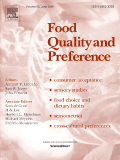New paper: Do Basic Tastes and Fattiness Sensitivity Influence Food Liking in Preadolescents?

There have been different studies established in the field of taste sensitivity and food liking. However, it is still uncertain how different taste sensitivity measures relate to each other and to food liking, especially in preadolescent subjects. Our study aimed to investigate the relationship between basic tastes sensitivity, fattiness sensitivity, and food liking in preadolescents.
In this study, the sensitivity to basic tastes was measured using different taste compounds such as sucrose (sweet), citric acid (sour), sodium chloride (salty), monosodium glutamate (umami), caffeine and quinine (bitter). These taste compounds were prepared in water solution, then each was served to the children at five different concentration levels. Different methods were also involved to measure the children’s basic tastes such as detection threshold, recognition threshold, taste responsiveness, and responsiveness to PROP (6-n-propylthiouracil) in paper strips. Fattiness sensitivity was measured using milk samples containing four different fat contents ranging from 0.5-3.5% milk fat. The children’s familiarity and liking of the 30 different food items were also recorded in the form of a questionnaire. These evaluations were packed in a gamified approach called the “Taste Detective Game”. The children were engaged and had fun in following all the taste tests in the game.
Based on our results, we found that the detection and recognition threshold were strongly correlated for all basic tastes. Moreover, responsiveness to PROP correlates with overall taste responsiveness. Interestingly, boys and girls showed a different detection threshold levels, indicating a lower sensitivity in boys compared to girls, particularly for sweet and bitter taste. Caffeine and quinine sensitivity were also observed to be different for their bitterness responsiveness and liking, signalling individual differences in bitter taste sensitivity of different bitter compounds, among the children. We did not find a strong influence of basic tastes sensitivity and food liking, but there is a significant effect of fattiness sensitivity and the liking of fatty foods. Food liking is strongly driven by different tastes and fattiness properties of the foods.
This study contributes to a better understanding of taste and fattiness sensitivity in relation to preadolescent’s food liking. In the next study, we will implement the use of real food samples (model foods) to investigate children’s taste sensitivity and their hedonic responses. We will also include other factors such as children’s exposure to foods.
The complete article is published in Food Quality and preference, and is entitled: “Investigating the Relationships between Basic Tastes Sensitivities, Fattiness Sensitivity, and Food Liking in 11-Year-Old Children” and can be found here, DOI: https://doi.org/10.3390/foods9091315
ESR2, gamification, pre-adolescents, sensory sensitivity, taste detective



